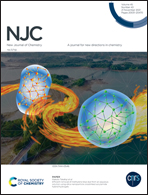Surface adhered fluorescent carbon dots extracted from the harmful diesel soot for sensing Fe(iii) and Hg(ii) ions†
Abstract
Herein, a simpler isolation method has been proposed for using the loosely adsorbed surface-adhered waste from the surface of pollutant diesel soot (DS). The simple extraction protocol is based on Soxhlet-purification using acetone to extract the acetone-soluble fluorescent fraction from the bulk DS. The acetone soluble fraction contains some fraction that should be soluble in aqueous medium. So a gel-separation technique was used to separate the highly fluorescent water-soluble fraction of nano-carbons from the bulk. Transmission electron microscopy analysis reveals the carbon dot (CDs) like morphology of the as-extracted blue–green fluorescent water-soluble fraction. These CDs show strong fluorescence photostability (checked up to 4 hours) and have ∼8% quantum yield. The fluorescent water-soluble CDs are used for the selective sensing of Fe(III) and toxic-Hg(II) metal ions among most all the tested metal ions. To determine the plausible quenching mechanism, spectral overlap analysis and time-resolved photoluminescence analysis were performed. The fluorescence quenching by Fe(III) was mainly attributed to the inner filter effect (IFE) mechanism while in the case of Hg(II) ions, quenching was because of the ligand to metal charge transfer (LMCT) mechanism. The sensing of metal ions was additionally supported with the aid of cyclic voltammetry analysis.



 Please wait while we load your content...
Please wait while we load your content...